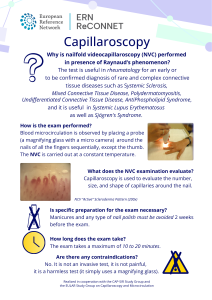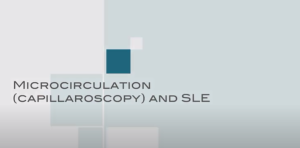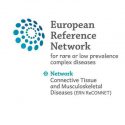ERN ReCONNET
Disease Info
Disease: Systemic Lupus Erythematosus
Systemic Lupus Erythematosus (SLE)
What is SLE?
Clinical overview of the disease
Systemic Lupus Erythematous (SLE) is the paradigm of systemic autoimmune diseases characterized by a multifaceted presentation and an unpredictable relapsing-remitting course. SLE typically affects young women between 16 and 55 years, but it can also affect men and may onset in childhood. The disease can involve almost all organs and tissues in affected individuals. It’s typically characterised by the loss of self-tolerance and formation of nuclear autoantibodies, immune complexes and complement activation resulting in inflammation of multiple organs. More recently, it was discovered that autoantibodies induce the influx of neutrophils that dying release ‘spider web’ like chromatin fibres called neutrophil extracellular traps (NETs) activating NETosis which generate/trap autoantigens and aggravate inflammation. Some of the most common clinical features are: mucocutaneous lesions, articular manifestations, renal involvement, haematological disorders, neurological involvement serositis and fever. Lupus nephritis (LN) is one the most serious and threatening complications that can lead to chronic kidney failure in most severe cases.
The serological picture of SLE is characterized by the positivity of antinuclear autoantibodies among which the most specific are antidsDNA and anti-Sm. In addition, the cooccurrence of concomitant antiphospholipid syndrome with positive antiphospholipid (aPL) antibodies is possible, which is associated with a worse prognosis. During SLE course patients may develop both disease- and treatment-related damage that can have a lasting impact on quality of life.
Although the better use of the available therapies has greatly improved SLE patients’ outcome, the disease is still associated with a significant morbidity. Therefore, timely and proper diagnosis and treatment is crucial in order to prevent long-term complications and to improve quality of life in these patients. Several new drugs have been developed in the last few years that target specific key elements of inflammation. The treatment strategy is the result of combination of antimalarial drug, glucocorticoids and immunosuppressant based on the manifestation and severity of the disease.
Nowadays, a treat-to-target approach is the mainstream for the treatment of SLE patients with the purpose that the management strategies should be tailored to the organ system involved to achieve remission of systemic symptoms and organ manifestations or, where remission cannot be reached, the lowest possible disease activity, measured by a validated lupus activity index and/or by organ-specific markers. For women of childbearing age, pregnancy should be carefully planned to avoid pregnancy complications and ensure a safe pregnancy outcome.
Over the past 50 years, the long-term survival of patients with SLE has dramatically improved.
Clinical overview of the disease
The serological picture of SLE is characterized by the positivity of antinuclear autoantibodies among which the most specific are antidsDNA and anti-Sm. In addition, the cooccurrence of concomitant antiphospholipid syndrome with positive antiphospholipid (aPL) antibodies is possible, which is associated with a worse prognosis. During SLE course patients may develop both disease- and treatment-related damage that can have a lasting impact on quality of life.
Although the better use of the available therapies has greatly improved SLE patients’ outcome, the disease is still associated with a significant morbidity. Therefore, timely and proper diagnosis and treatment is crucial in order to prevent long-term complications and to improve quality of life in these patients. Several new drugs have been developed in the last few years that target specific key elements of inflammation. The treatment strategy is the result of combination of antimalarial drug, glucocorticoids and immunosuppressant based on the manifestation and severity of the disease.
Nowadays, a treat-to-target approach is the mainstream for the treatment of SLE patients with the purpose that the management strategies should be tailored to the organ system involved to achieve remission of systemic symptoms and organ manifestations or, where remission cannot be reached, the lowest possible disease activity, measured by a validated lupus activity index and/or by organ-specific markers. For women of childbearing age, pregnancy should be carefully planned to avoid pregnancy complications and ensure a safe pregnancy outcome.
Over the past 50 years, the long-term survival of patients with SLE has dramatically improved.
Laurent Arnaud
Laurent Arnaud
Disease Coordinator
Disease Coordinator
Epidemiology
The prevalence of SLE is highest in women (between 16-55 years old) and in non-white populations (African Americans, Asians, Hispanics, and Native Americans), with an estimated prevalence in adults of 30-150 per 100 000, and incidence ranges from 2.2 to 23.1 per 100 000 per year. However, children are also affected, although SLE is less common in this population, without the gender bias seen in adults, with a reported incidence of 0.3-0.9 per 100 000 children per year, and a prevalence of 3.3-24 per 100 000 children.
Risk factors and possible causes
SLE aetiology is multifactorial including genetic, epigenetic risk factors and environmental trigger that led to an activation of innate and adaptative immune system. A genetic predisposition has been demonstrated in several studies where a 10-fold increased risk of SLE in monozygotic twins has been evaluated. Environmental factors as ultraviolet light exposure, infections, toxins, hormones, smoking cigarettes, silica dust, moderate use of alcohol and different medications (penicillin, sulfa drugs, codeine, procainide, isoniazid and hydralazine) have been identified as possible risk factors for the disease. Especially hormones have been demonstrated a key role, specifically estrogen, this might explain the higher prevalence in females. Considering the underlying potential mechanism that leads to SLE, it appears that it is the result of an interplay of complex mechanism not fully understood, where there is a disturbance of immune tolerance. This involves the adaptative immune response as well as the innate immune response triggered by stimulus in a specific genetic background, leading to Interferon-I pathway activation, immune activation and autoantibody production, generation of inflammatory mediators and activation of the complement system, resulting in tissue damage. Additionally, an uncontrolled NETosis, a specific program of cellular death mediated by neutrophil, is increased and generate/trap autoantigens and aggravate inflammation.
Common symptoms: Signs and symptoms
SLE typically shows an extremely variable presentations, considering its possible diverse organ involvement. The symptoms might be distinguished in constitutional and organ specific. As constitutional symptoms extremely common are fatigue, presents in almost all patients, fever and weight loss. Among the organ specific manifestations, they might classify based on the organ/system involved:
- Mucocutaneous symptoms are one of the most affected organs in the context of a multisystemic presentation, but it may be involved in an isolated way as cutaneous LE. Among this group of manifestations, the most frequently reported are the malar rash, discoid lesions, photosensitivity, subacute cutaneous LE, alopecia, panniculitis, livedo reticularis, Raynaud phenomenon, lichen planus, bullous lesions.
- Musculoskeletal symptoms may be reported in terms of arthralgia and/or a real arthritis. Less frequently osteonecrosis-avascular necrosis of bone and myopathy may be also present.
- Antibodies usually show as antinuclear antibodies (ANA), antidsDNA and anti-Sm, which may be present several years before the appearance of the clinical manifestation.
- Haematology/lymphatic abnormalities are one the others key manifestations of SLE, that may be present as leukopenia, thrombocytopenia and or anaemia..
- Thrombotic events and antiphospholipid syndrome: There are additional manifestations as thrombotic events when antiphospholipid autoantibodies are presents including anti-beta2microglobulin IgG and IgM, anti-cardiolipin IgG and IgM and lupus anticoagulant. The thrombotic events may be venous but also arterial.
- Renal abnormalities: lupus nephritis is one of the most notable SLE manifestations that increases the morbidity and mortality of the disease. The dominant feature is proteinuria with active sediment abnormalities. In severe cases can lead to chronic renal failure. Based upon histopathologic evaluation, six different classes of lupus nephritis are distinguished, which have different therapeutic consequences.
- Neuropsychiatric manifestations can also be present, and they include several symptoms such as headache, seizure disorder, psychosis, acute confusional state and cognitive dysfunction.
- Gastrointestinal system may be involved although less frequently. Abdominal pain may be reported as secondary to mesenteric vasculitis and thrombosis that lead to ischemia and infarction. Additional possible manifestations may be hepatitis, pancreatitis or intestinal pseudo-obstruction.
- Lung usually is involved later in the disease course and the most common manifestations is pleuritis followed by others more rare manifestations as pulmonary hypertension and chronic interstitial disease.
- Cardiovascular system may be involved as valvular heart disease as Libman-sacks lesions with sterile vegetation or serositis with pericardial disease.
- Pregnancy morbidities: Women in childbearing age should be aware of possible pregnancy complications and morbidity and this key moment of their life should be planned in order to minimize possible consequence for the mother and the newborn. Pregnancy complications and morbidities can be distinguished in delay in pursuing pregnancy, diminished ovarian reserve, increased risk of abortus, lupus flare, preterm delivery and specific direct consequences on the newborn called neonatal lupus. Neonatal lupus happens when specific antibodies of the mother, if positive anti-Ro or anti-La, cross the placental barrier and arrive in the foetal blood and can lead to several fearsome consequences that can start during the intrauterine life as the congenital heart block, or later after the delivery as anaemia or rash. However, many of these complications resolve by progressively eliminating maternal antibodies, but others that are structural persist for the entire life as congenital heart block.
- Other manifestations: The eye might be involved in term of optic nerve, periorbita and ocular annex. The most frequent manifestation is the keratoconjunctivitis sicca, characterized by persistent eye dryness, followed by the optic neuritis and ischemic optic neuropathy and retinal vaso-occlusion that is like diabetic and hypertensive retinopathy, which then may seriously threaten visual acuity.
There are some additional manifestations that are considered rare because reported in a low proportion of patients with SLE.
For more details see Tani C, et al. Clin Exp Rheumatol. 2022;40 Suppl 134(5):93-102.
Childhood SLE shows similar clinical manifestations but with different frequencies.
When to see a doctor?
If you have developed in the last months fatigue, weight loss, photosensitivity, malar rash, arthralgia/arthritis, oral ulcers, fever, ecchymosis/haemorrhagic episodes without a clear explanation, protein in the urine, seizure or thromboembolic events, probably it is better to see your doctor. Your doctors will evaluate you and wisely select reasonable tests and the workup to perform including autoimmunity.
Diagnosis (path/tests/differential diagnosis)
The diagnosis is based on clinical, anamnestic as well as laboratory and immunological findings. The classification criteria of the ACR/EULAR can support diagnosis, as they list the main manifestations of SLE. However, they are explicitly not diagnostic criteria., and have been formulated for research purpose. The diagnosis as well as any differential diagnoses must be made or excluded clinically by the treating physician.
The clinical manifestations in combinations with specific blood abnormalities as presence of ANA, antidsDNA or anti-Sm, c3, c4, low white blood cells, low platelets, inflammatory index including ESR and CRP can help in formulating the correct diagnosis.
Common laboratory tests are extremely useful as cell blood count, liver and kidney function, urine analysis, complement level (c3, c4), inflammatory index (ESR and CRP) and the autoimmunity including the ANA status, antidsDNA, anti-Sm and anti-beta2glycoproteins and anticardiolipin.
In the differential diagnosis several diseases should be taken into account including infections, malignancies and the possibility of drug induced SLE.
Because of blood manifestations leukaemia and lymphoma should be considered in the differential diagnosis, as well as infections (e.g., Leishmania, EBV, Lyme diseases, brucellosis). Additionally, other possible autoimmune diseases should be considered in the differential diagnosis based on the manifestations shown by the patients and include rheumatoid arthritis, other connective-tissue diseases (e.g., polymyositis, undifferentiated connective tissue disease, mixed connective tissue disease) or antiphospholipid syndrome.
Additional instrumental test might be performed based on the clinical manifestation including chest Xray, echocardiography, brain MRI, doppler of vessel.
The kidney biopsy is the mainstream to evaluate the lupus nephritis in order to grade the class and severity of kidney involvement and choose the appropriate treatment.
Treatments overview
Treatment of SLE is still a challenging topic, but the steps forward of the research have led to the identification of specific therapy that target keys molecules and pathways involved in SLE. The clinicians are helped to find the better treatment for each patient thanks to international guidelines in order to achieve the “target” of remission or low disease activity. However, the management is not same for all the patients with SLE, and often depends on disease severity and different organ involvement. The cornerstone of the treatment in all patients is hydroxychloroquine regardless of disease manifestation, reducing the risk of flares. Corticosteroids and immunosuppressant are the other key treatments, which are chosen based on organ manifestation and disease severity. The use of corticosteroids should be preferably as short and low as possible. Immunosuppressant as methotrexate, azathioprine and cyclophosphamide are usually used, but newer biologic drugs as belimumab, rituximab and anifrolumab are becoming part of the common treatment.
Management strategy should include not only specific therapy but also a series of actions that include:
- The ultraviolet avoidance using the sunscreen and avoiding direct sunlight
- Promoting the cardiovascular health with weight management, smoking cessation, management of hypertension and dyslipidaemia
- Vaccination prior to immunosuppression if it is possible in order to prevent infections (e.g., influenza, pneumococcus, papillomavirus or herpes zoster vaccination)
- Bone health especially for patients using chronic corticosteroids in order to prevent fractures
- Management of pain
- Reproductive health: discuss contraception and plan pregnancies in order to find the best moment for this delicate phase of the women life if desired
- Anti-thrombotic/antiphospholipid evaluation: routinely screen for antiphospholipid autoantibody and start primary or secondary prophylaxis as appropriate
Prognosis
The prognosis of SLE patients have been improved in the last decades, with an amelioration in the quality of life and clinical manifestations. However, despite advances in therapy, the mortality associated with SLE remains considerable with a standard mortality rate that is still more than twice as high as that of the normal population. Usually, a death in the first phase of the disease is secondary to active disease and infection, whereas later mortality is often due to organ damage, corticosteroid-mediated injury, and cardiovascular disease.
The presence of lupus nephritis or neuropsychiatric lupus unfortunately increase the mortality.
Adverse outcomes are more common in men than in women, and specific factors associated with adverse outcomes include poor adherence and attendance at clinic appointments, low income, and the presence of haemolytic anaemia and nephritis, hypertension, antiphospholipid syndrome, and low complement.
ERN ReCONNET publications are available for consultation.
Additional info
Find reliable, quality answers on the 100 most frequent questions about lupus, written by leading lupus doctors in collaboration with patients.
Lupus 100 is a cooperation between Lupus Europe, FAI²R, ERN ReCONNET and Éditions Katana Santé
LIST OF USEFUL REFERENCES
2021 DORIS definition of remission in SLE: final recommendations from an international task force
van Vollenhoven RF, Bertsias G, Doria A, Isenberg D, Morand E, Petri MA, Pons-Estel BA, Rahman A, Ugarte-Gil MF, Voskuyl A, Arnaud L, Bruce IN, Cervera R, Costedoat-Chalumeau N, Gordon C, Houssiau FA, Mosca M, Schneider M, Ward MM, Alarcon G, Aringer M, Askenase A, Bae SC, Bootsma H, Boumpas DT, Brunner H, Clarke AE, Coney C, Czirják L, Dörner T, Faria R, Fischer R, Fritsch-Stork R, Inanc M, Jacobsen S, Jayne D, Kuhn A, van Leeuw B, Limper M, Mariette X, Navarra S, Nikpour M, Olesinska MH, Pons-Estel G, Romero-Diaz J, Rubio B, Schoenfeld Y, Bonfá E, Smolen J, Teng YKO, Tincani A, Tsang-A-Sjoe M, Vasconcelos C, Voss A, Werth VP, Zakharhova E, Aranow C.
Lupus Sci Med. 2021 Nov;8(1):e000538.
Safety management in treatment with antimalarials in rheumatology. Interdisciplinary recommendations on the basis of a systematic literature review
Fiehn C, Ness T, Weseloh C, Specker C, Hadjiski D, Detert J, Krüger K; DGRh Kommission Pharmakotherapie.
Z Rheumatol. 2021 Feb;80(Suppl 1):1-9.
Neonatal lupus erythematosus – practical guidelines
Derdulska JM, Rudnicka L, Szykut-Badaczewska A, Mehrholz D, Nowicki RJ, Barańska-Rybak W, Wilkowska A.
J Perinat Med. 2021 Jan 18;49(5):529-538.
2019 update of the EULAR recommendations for the management of systemic lupus erythematosus
Fanouriakis A, Kostopoulou M, Alunno A, Aringer M, Bajema I, Boletis JN, Cervera R, Doria A, Gordon C, Govoni M, Houssiau F, Jayne D, Kouloumas M, Kuhn A, Larsen JL, Lerstrøm K, Moroni G, Mosca M, Schneider M, Smolen JS, Svenungsson E, Tesar V, Tincani A, Troldborg A, van Vollenhoven R, Wenzel J, Bertsias G, Boumpas DT.
Ann Rheum Dis. 2019 Jun;78(6):736-745.
The British Society for Rheumatology guideline for the management of systemic lupus erythematosus in adults
Gordon C, Amissah-Arthur MB, Gayed M, Brown S, Bruce IN, D’Cruz D, Empson B, Griffiths B, Jayne D, Khamashta M, Lightstone L, Norton P, Norton Y, Schreiber K, Isenberg D; British Society for Rheumatology Standards, Audit and Guidelines Working Group.
Rheumatology (Oxford). 2018 Jan 1;57(1):e1-e45.
European evidence-based recommendations for the diagnosis and treatment of childhood-onset lupus nephritis: the SHARE initiative
Groot N, de Graeff N, Marks SD, Brogan P, Avcin T, Bader-Meunier B, Dolezalova P, Feldman BM, Kone-Paut I, Lahdenne P, McCann L, Özen S, Pilkington CA, Ravelli A, Royen-Kerkhof AV, Uziel Y, Vastert BJ, Wulffraat NM, Beresford MW, Kamphuis S.
Ann Rheum Dis. 2017 Dec;76(12):1965-73.
2017 American College of Rheumatology/American Association of Hip and Knee Surgeons Guideline for the Perioperative Management of Antirheumatic Medication in Patients With Rheumatic Diseases Undergoing Elective Total Hip or Total Knee Arthroplasty
Goodman SM, Springer B, Guyatt G, Abdel MP, Dasa V, George M, Gewurz-Singer O, Giles JT, Johnson B, Lee S, Mandl LA, Mont MA, Sculco P, Sporer S, Stryker L, Turgunbaev M, Brause B, Chen AF, Gililland J, Goodman M, Hurley-Rosenblatt A, Kirou K, Losina E, MacKenzie R, Michaud K, Mikuls T, Russell L, Sah A, Miller AS, Singh JA, Yates A.
Arthritis Rheumatol. 2017 Aug;69(8):1538-51.
EULAR recommendations for women’s health and the management of family planning, assisted reproduction, pregnancy and menopause in patients with systemic lupus erythematosus and/or antiphospholipid syndrome
Andreoli L, Bertsias GK, Agmon-Levin N, Brown S, Cervera R, Costedoat-Chalumeau N, Doria A, Fischer-Betz R, Forger F, Moraes-Fontes MF, Khamashta M, King J, Lojacono A, Marchiori F, Meroni PL, Mosca M, Motta M, Ostensen M, Pamfil C, Raio L, Schneider M, Svenungsson E, Tektonidou M, Yavuz S, Boumpas D, Tincani A.
Ann Rheum Dis. 2017 Mar;76(3):476-85.
The EULAR points to consider for use of antirheumatic drugs before pregnancy, and during pregnancy and lactation
Götestam Skorpen C, Hoeltzenbein M, Tincani A, Fischer-Betz R, Elefant E, Chambers C, da Silva J, Nelson-Piercy C, Cetin I, Costedoat-Chalumeau N, Dolhain R, Förger F, Khamashta M, Ruiz-Irastorza G, Zink A, Vencovsky J, Cutolo M, Caeyers N, Zumbühl C, Østensen M.
Ann Rheum Dis. 2016 May;75(5):795-810.
[Clinical practice guidelines for systemic lupus erythematosus: Recommendations for general clinical management]
Trujillo-Martín MM, Rúa-Figueroa Fernández de Larrinoa I, Ruíz-Irastorza G, Pego-Reigosa JM, Sabio Sánchez JM, Serrano-Aguilar P; en nombre del Grupo Elaborador de la GPC-LES.
Med Clin (Barc). 2016 May 6;146(9):413.e1-14.
[Prevention of infections in adults and adolescents with systemic lupus erythematosus: Guidelines for the clinical practice based on the literature and expert opinion]
Mathian A, Arnaud L, Adoue D, Agard C, Bader-Meunier B, Baudouin V, Belizna C, Bonnotte B, Boumedine F, Chaib A, Chauchard M, Chiche L, Daugas E, Ghali A, Gobert P, Gondran G, Guettrot-Imbert G, Hachulla E, Hamidou M, Haroche J, Hervier B, Hummel A, Jourde-Chiche N, Korganow AS, Kwon T, Le Guern V, Le Quellec A, Limal N, Magy-Bertrand N, Marianetti-Guingel P, Martin T, Martin Silva N, Meyer O, Miyara M, Morell-Dubois S, Ninet J, Pennaforte JL, Polomat K, Pourrat J, Queyrel V, Raymond I, Remy P, Sacre K, Sibilia J, Viallard JF, Viau Brabant A, Hanslik T, Amoura Z; le groupe France lupus érythémateux systémique réseau (FLEUR) et les centres de référence et de compétence des lupus et syndromes des antiphospholipides.
Rev Med Interne. 2016 May;37(5):307-20.
Clinical practice guidelines for the management of pregnancy in women with autoimmune rheumatic diseases of the Mexican College of Rheumatology. Part II
Saavedra Salinas MÁ, Barrera Cruz A, Cabral Castañeda AR, Jara Quezada LJ, Arce-Salinas CA, Álvarez Nemegyei J, Fraga Mouret A, Orozco Alcalá J, Salazar Páramo M, Cruz Reyes CV, Andrade Ortega L, Vera Lastra OL, Mendoza Pinto C, Sánchez González A, Cruz Cruz Pdel R, Morales Hernández S, Portela Hernández M, Pérez Cristóbal M, Medina García G, Hernández Romero N, Velarde Ochoa Mdel C, Navarro Zarza JE, Portillo Díaz V, Vargas Guerrero A, Goycochea Robles MV, García Figueroa JL, Barreira Mercado E, Amigo Castañeda MC.
Reumatol Clin. 2015 Sep-Oct;11(5):305-15.
Clinical practice guidelines for the management of pregnancy in women with autoimmune rheumatic diseases of the Mexican College of Rheumatology. Part I
Saavedra Salinas MÁ, Barrera Cruz A, Cabral Castañeda AR, Jara Quezada LJ, Arce-Salinas CA, Álvarez Nemegyei J, Fraga Mouret A, Orozco Alcalá J, Salazar Páramo M, Cruz Reyes CV, Andrade Ortega L, Vera Lastra OL, Mendoza Pinto C, Sánchez González A, Cruz Cruz Pdel R, Morales Hernández S, Portela Hernández M, Pérez Cristóbal M, Medina García G, Hernández Romero N, Velarde Ochoa Mdel C, Navarro Zarza JE, Portillo Díaz V, Vargas Guerrero A, Goycochea Robles MV, García Figueroa JL, Barreira Mercado E, Amigo Castañeda MC.
Reumatol Clin. 2015 Sep-Oct;11(5):295-304.
[Recommendations from the Brazilian Society of Rheumatology on the diagnosis and treatment of intestinal parasitic infections in patients with autoimmune rheumatic disorders]
Braz AS, de Andrade CA, da Mota LM, Lima CM.
Rev Bras Reumatol. 2015 Jul-Aug;55(4):368-80.
[Screening and management of cardiovascular risk factors in systemic lupus erythematosus: Recommendations for clinical practice based on the literature and expert opinion]
Arnaud L, Mathian A, Adoue D, Bader-Meunier B, Baudouin V, Belizna C, Bonnotte B, Boumedine F, Chaib A, Chauchard M, Chiche L, Daugas E, Ghali A, Gobert P, Gondran G, Guettrot-Imbert G, Hachulla E, Hamidou M, Haroche J, Hervier B, Hummel A, Jourde-Chiche N, Korganow AS, Kwon T, Le Guern V, Le Quellec A, Limal N, Magy-Bertrand N, Marianetti-Guingel P, Martin T, Martin Silva N, Meyer O, Miyara M, Morell-Dubois S, Ninet J, Papo T, Pennaforte JL, Polomat K, Pourrat J, Queyrel V, Raymond I, Remy P, Sacre K, Schmidt J, Sibilia J, Viallard JF, Viau Brabant A, Wahl D, Bruckert E, Amoura Z; groupe France Lupus Érythémateux systémique Réseau (FLEUR) et les centres de référence et de compétence des lupus et syndromes des antiphospholipides.
Rev Med Interne. 2015 Jun;36(6):372-80.
Treat-to-target in systemic lupus erythematosus: recommendations from an international task force
van Vollenhoven RF, Mosca M, Bertsias G, Isenberg D, Kuhn A, Lerstrøm K, Aringer M, Bootsma H, Boumpas D, Bruce IN, Cervera R, Clarke A, Costedoat-Chalumeau N, Czirják L, Derksen R, Dörner T, Gordon C, Graninger W, Houssiau F, Inanc M, Jacobsen S, Jayne D, Jedryka-Goral A, Levitsky A, Levy R, Mariette X, Morand E, Navarra S, Neumann I, Rahman A, Rovensky J, Smolen J, Vasconcelos C, Voskuyl A, Voss A, Zakharova H, Zoma A, Schneider M.
Ann Rheum Dis. 2014 Jun;73(6):958-67.
Joint European League Against Rheumatism and European Renal Association-European Dialysis and Transplant Association (EULAR/ERA-EDTA) recommendations for the management of adult and paediatric lupus nephritis
Bertsias GK, Tektonidou M, Amoura Z, Aringer M, Bajema I, Berden JH, Boletis J, Cervera R, Dörner T, Doria A, Ferrario F, Floege J, Houssiau FA, Ioannidis JP, Isenberg DA, Kallenberg CG, Lightstone L, Marks SD, Martini A, Moroni G, Neumann I, Praga M, Schneider M, Starra A, Tesar V, Vasconcelos C, van Vollenhoven RF, Zakharova H, Haubitz M, Gordon C, Jayne D, Boumpas DT; European League Against Rheumatism and European Renal Association-European Dialysis and Transplant Association.
Ann Rheum Dis. 2012 Nov;71(11):1771-82.
American College of Rheumatology guidelines for screening, treatment, and management of lupus nephritis
Hahn BH, McMahon MA, Wilkinson A, Wallace WD, Daikh DI, Fitzgerald JD, Karpouzas GA, Merrill JT, Wallace DJ, Yazdany J, Ramsey-Goldman R, Singh K, Khalighi M, Choi SI, Gogia M, Kafaja S, Kamgar M, Lau C, Martin WJ, Parikh S, Peng J, Rastogi A, Chen W, Grossman JM; American College of Rheumatology.
Arthritis Care Res (Hoboken). 2012 Jun;64(6):797-808.
EULAR recommendations for vaccination in paediatric patients with rheumatic diseases
Heijstek MW, Ott de Bruin LM, Bijl M, Borrow R, van der Klis F, Koné-Paut I, Fasth A, Minden K, Ravelli A, Abinun M, Pileggi GS, Borte M, Wulffraat NM; EULAR.
Ann Rheum Dis. 2011 Oct;70(10):1704-12.
EULAR recommendations for the management of systemic lupus erythematosus with neuropsychiatric manifestations: report of a task force of the EULAR standing committee for clinical affairs
Bertsias GK, Ioannidis JP, Aringer M, Bollen E, Bombardieri S, Bruce IN, Cervera R, Dalakas M, Doria A, Hanly JG, Huizinga TW, Isenberg D, Kallenberg C, Piette JC, Schneider M, Scolding N, Smolen J, Stara A, Tassiulas I, Tektonidou M, Tincani A, van Buchem MA, van Vollenhoven R, Ward M, Gordon C, Boumpas DT.
Ann Rheum Dis. 2010 Dec;69(12):2074-82.
European League Against Rheumatism recommendations for monitoring patients with systemic lupus erythematosus in clinical practice and in observational studies
Mosca M, Tani C, Aringer M, Bombardieri S, Boumpas D, Brey R, Cervera R, Doria A, Jayne D, Khamashta MA, Kuhn A, Gordon C, Petri M, Rekvig OP, Schneider M, Sherer Y, Shoenfeld Y, Smolen JS, Talarico R, Tincani A, van Vollenhoven RF, Ward MM, Werth VP, Carmona L.
Ann Rheum Dis. 2010 Jul;69(7):1269-74.
EULAR recommendations for the management of systemic lupus erythematosus. Report of a Task Force of the EULAR Standing Committee for International Clinical Studies Including Therapeutics
Bertsias G, Ioannidis JP, Boletis J, Bombardieri S, Cervera R, Dostal C, Font J, Gilboe IM, Houssiau F, Huizinga T, Isenberg D, Kallenberg CG, Khamashta M, Piette JC, Schneider M, Smolen J, Sturfelt G, Tincani A, van Vollenhoven R, Gordon C, Boumpas DT; Task Force of the EULAR Standing Committee for International Clinical Studies Including Therapeutics.
Ann Rheum Dis. 2008 Feb;67(2):195-205.
Guidelines for immunologic laboratory testing in the rheumatic diseases: anti-Sm and anti-RNP antibody tests
Benito-Garcia E, Schur PH, Lahita R; American College of Rheumatology Ad Hoc Committee on Immunologic Testing Guidelines.
Arthritis Rheum. 2004 Dec 15;51(6):1030-44.
Guidelines for the laboratory use of autoantibody tests in the diagnosis and monitoring of autoimmune rheumatic diseases
Tozzoli R, Bizzaro N, Tonutti E, Villalta D, Bassetti D, Manoni F, Piazza A, Pradella M, Rizzotti P; Italian Society of Laboratory Medicine Study Group on the Diagnosis of Autoimmune Diseases.
Am J Clin Pathol. 2002 Feb;117(2):316-24.
van Vollenhoven RF, Bertsias G, Doria A, Isenberg D, Morand E, Petri MA, Pons-Estel BA, Rahman A, Ugarte-Gil MF, Voskuyl A, Arnaud L, Bruce IN, Cervera R, Costedoat-Chalumeau N, Gordon C, Houssiau FA, Mosca M, Schneider M, Ward MM, Alarcon G, Aringer M, Askenase A, Bae SC, Bootsma H, Boumpas DT, Brunner H, Clarke AE, Coney C, Czirják L, Dörner T, Faria R, Fischer R, Fritsch-Stork R, Inanc M, Jacobsen S, Jayne D, Kuhn A, van Leeuw B, Limper M, Mariette X, Navarra S, Nikpour M, Olesinska MH, Pons-Estel G, Romero-Diaz J, Rubio B, Schoenfeld Y, Bonfá E, Smolen J, Teng YKO, Tincani A, Tsang-A-Sjoe M, Vasconcelos C, Voss A, Werth VP, Zakharhova E, Aranow C.
Lupus Sci Med. 2021 Nov;8(1):e000538.
Fiehn C, Ness T, Weseloh C, Specker C, Hadjiski D, Detert J, Krüger K; DGRh Kommission Pharmakotherapie.
Z Rheumatol. 2021 Feb;80(Suppl 1):1-9.
Derdulska JM, Rudnicka L, Szykut-Badaczewska A, Mehrholz D, Nowicki RJ, Barańska-Rybak W, Wilkowska A.
J Perinat Med. 2021 Jan 18;49(5):529-538.
Fanouriakis A, Kostopoulou M, Alunno A, Aringer M, Bajema I, Boletis JN, Cervera R, Doria A, Gordon C, Govoni M, Houssiau F, Jayne D, Kouloumas M, Kuhn A, Larsen JL, Lerstrøm K, Moroni G, Mosca M, Schneider M, Smolen JS, Svenungsson E, Tesar V, Tincani A, Troldborg A, van Vollenhoven R, Wenzel J, Bertsias G, Boumpas DT.
Ann Rheum Dis. 2019 Jun;78(6):736-745.
Gordon C, Amissah-Arthur MB, Gayed M, Brown S, Bruce IN, D’Cruz D, Empson B, Griffiths B, Jayne D, Khamashta M, Lightstone L, Norton P, Norton Y, Schreiber K, Isenberg D; British Society for Rheumatology Standards, Audit and Guidelines Working Group.
Rheumatology (Oxford). 2018 Jan 1;57(1):e1-e45.
Groot N, de Graeff N, Marks SD, Brogan P, Avcin T, Bader-Meunier B, Dolezalova P, Feldman BM, Kone-Paut I, Lahdenne P, McCann L, Özen S, Pilkington CA, Ravelli A, Royen-Kerkhof AV, Uziel Y, Vastert BJ, Wulffraat NM, Beresford MW, Kamphuis S.
Ann Rheum Dis. 2017 Dec;76(12):1965-73.
Goodman SM, Springer B, Guyatt G, Abdel MP, Dasa V, George M, Gewurz-Singer O, Giles JT, Johnson B, Lee S, Mandl LA, Mont MA, Sculco P, Sporer S, Stryker L, Turgunbaev M, Brause B, Chen AF, Gililland J, Goodman M, Hurley-Rosenblatt A, Kirou K, Losina E, MacKenzie R, Michaud K, Mikuls T, Russell L, Sah A, Miller AS, Singh JA, Yates A.
Arthritis Rheumatol. 2017 Aug;69(8):1538-51.
Andreoli L, Bertsias GK, Agmon-Levin N, Brown S, Cervera R, Costedoat-Chalumeau N, Doria A, Fischer-Betz R, Forger F, Moraes-Fontes MF, Khamashta M, King J, Lojacono A, Marchiori F, Meroni PL, Mosca M, Motta M, Ostensen M, Pamfil C, Raio L, Schneider M, Svenungsson E, Tektonidou M, Yavuz S, Boumpas D, Tincani A.
Ann Rheum Dis. 2017 Mar;76(3):476-85.
Götestam Skorpen C, Hoeltzenbein M, Tincani A, Fischer-Betz R, Elefant E, Chambers C, da Silva J, Nelson-Piercy C, Cetin I, Costedoat-Chalumeau N, Dolhain R, Förger F, Khamashta M, Ruiz-Irastorza G, Zink A, Vencovsky J, Cutolo M, Caeyers N, Zumbühl C, Østensen M.
Ann Rheum Dis. 2016 May;75(5):795-810.
Trujillo-Martín MM, Rúa-Figueroa Fernández de Larrinoa I, Ruíz-Irastorza G, Pego-Reigosa JM, Sabio Sánchez JM, Serrano-Aguilar P; en nombre del Grupo Elaborador de la GPC-LES.
Med Clin (Barc). 2016 May 6;146(9):413.e1-14.
Mathian A, Arnaud L, Adoue D, Agard C, Bader-Meunier B, Baudouin V, Belizna C, Bonnotte B, Boumedine F, Chaib A, Chauchard M, Chiche L, Daugas E, Ghali A, Gobert P, Gondran G, Guettrot-Imbert G, Hachulla E, Hamidou M, Haroche J, Hervier B, Hummel A, Jourde-Chiche N, Korganow AS, Kwon T, Le Guern V, Le Quellec A, Limal N, Magy-Bertrand N, Marianetti-Guingel P, Martin T, Martin Silva N, Meyer O, Miyara M, Morell-Dubois S, Ninet J, Pennaforte JL, Polomat K, Pourrat J, Queyrel V, Raymond I, Remy P, Sacre K, Sibilia J, Viallard JF, Viau Brabant A, Hanslik T, Amoura Z; le groupe France lupus érythémateux systémique réseau (FLEUR) et les centres de référence et de compétence des lupus et syndromes des antiphospholipides.
Rev Med Interne. 2016 May;37(5):307-20.
Saavedra Salinas MÁ, Barrera Cruz A, Cabral Castañeda AR, Jara Quezada LJ, Arce-Salinas CA, Álvarez Nemegyei J, Fraga Mouret A, Orozco Alcalá J, Salazar Páramo M, Cruz Reyes CV, Andrade Ortega L, Vera Lastra OL, Mendoza Pinto C, Sánchez González A, Cruz Cruz Pdel R, Morales Hernández S, Portela Hernández M, Pérez Cristóbal M, Medina García G, Hernández Romero N, Velarde Ochoa Mdel C, Navarro Zarza JE, Portillo Díaz V, Vargas Guerrero A, Goycochea Robles MV, García Figueroa JL, Barreira Mercado E, Amigo Castañeda MC.
Reumatol Clin. 2015 Sep-Oct;11(5):305-15.
Saavedra Salinas MÁ, Barrera Cruz A, Cabral Castañeda AR, Jara Quezada LJ, Arce-Salinas CA, Álvarez Nemegyei J, Fraga Mouret A, Orozco Alcalá J, Salazar Páramo M, Cruz Reyes CV, Andrade Ortega L, Vera Lastra OL, Mendoza Pinto C, Sánchez González A, Cruz Cruz Pdel R, Morales Hernández S, Portela Hernández M, Pérez Cristóbal M, Medina García G, Hernández Romero N, Velarde Ochoa Mdel C, Navarro Zarza JE, Portillo Díaz V, Vargas Guerrero A, Goycochea Robles MV, García Figueroa JL, Barreira Mercado E, Amigo Castañeda MC.
Reumatol Clin. 2015 Sep-Oct;11(5):295-304.
Braz AS, de Andrade CA, da Mota LM, Lima CM.
Rev Bras Reumatol. 2015 Jul-Aug;55(4):368-80.
Arnaud L, Mathian A, Adoue D, Bader-Meunier B, Baudouin V, Belizna C, Bonnotte B, Boumedine F, Chaib A, Chauchard M, Chiche L, Daugas E, Ghali A, Gobert P, Gondran G, Guettrot-Imbert G, Hachulla E, Hamidou M, Haroche J, Hervier B, Hummel A, Jourde-Chiche N, Korganow AS, Kwon T, Le Guern V, Le Quellec A, Limal N, Magy-Bertrand N, Marianetti-Guingel P, Martin T, Martin Silva N, Meyer O, Miyara M, Morell-Dubois S, Ninet J, Papo T, Pennaforte JL, Polomat K, Pourrat J, Queyrel V, Raymond I, Remy P, Sacre K, Schmidt J, Sibilia J, Viallard JF, Viau Brabant A, Wahl D, Bruckert E, Amoura Z; groupe France Lupus Érythémateux systémique Réseau (FLEUR) et les centres de référence et de compétence des lupus et syndromes des antiphospholipides.
Rev Med Interne. 2015 Jun;36(6):372-80.
van Vollenhoven RF, Mosca M, Bertsias G, Isenberg D, Kuhn A, Lerstrøm K, Aringer M, Bootsma H, Boumpas D, Bruce IN, Cervera R, Clarke A, Costedoat-Chalumeau N, Czirják L, Derksen R, Dörner T, Gordon C, Graninger W, Houssiau F, Inanc M, Jacobsen S, Jayne D, Jedryka-Goral A, Levitsky A, Levy R, Mariette X, Morand E, Navarra S, Neumann I, Rahman A, Rovensky J, Smolen J, Vasconcelos C, Voskuyl A, Voss A, Zakharova H, Zoma A, Schneider M.
Ann Rheum Dis. 2014 Jun;73(6):958-67.
Bertsias GK, Tektonidou M, Amoura Z, Aringer M, Bajema I, Berden JH, Boletis J, Cervera R, Dörner T, Doria A, Ferrario F, Floege J, Houssiau FA, Ioannidis JP, Isenberg DA, Kallenberg CG, Lightstone L, Marks SD, Martini A, Moroni G, Neumann I, Praga M, Schneider M, Starra A, Tesar V, Vasconcelos C, van Vollenhoven RF, Zakharova H, Haubitz M, Gordon C, Jayne D, Boumpas DT; European League Against Rheumatism and European Renal Association-European Dialysis and Transplant Association.
Ann Rheum Dis. 2012 Nov;71(11):1771-82.
Hahn BH, McMahon MA, Wilkinson A, Wallace WD, Daikh DI, Fitzgerald JD, Karpouzas GA, Merrill JT, Wallace DJ, Yazdany J, Ramsey-Goldman R, Singh K, Khalighi M, Choi SI, Gogia M, Kafaja S, Kamgar M, Lau C, Martin WJ, Parikh S, Peng J, Rastogi A, Chen W, Grossman JM; American College of Rheumatology.
Arthritis Care Res (Hoboken). 2012 Jun;64(6):797-808.
Heijstek MW, Ott de Bruin LM, Bijl M, Borrow R, van der Klis F, Koné-Paut I, Fasth A, Minden K, Ravelli A, Abinun M, Pileggi GS, Borte M, Wulffraat NM; EULAR.
Ann Rheum Dis. 2011 Oct;70(10):1704-12.
Bertsias GK, Ioannidis JP, Aringer M, Bollen E, Bombardieri S, Bruce IN, Cervera R, Dalakas M, Doria A, Hanly JG, Huizinga TW, Isenberg D, Kallenberg C, Piette JC, Schneider M, Scolding N, Smolen J, Stara A, Tassiulas I, Tektonidou M, Tincani A, van Buchem MA, van Vollenhoven R, Ward M, Gordon C, Boumpas DT.
Ann Rheum Dis. 2010 Dec;69(12):2074-82.
Mosca M, Tani C, Aringer M, Bombardieri S, Boumpas D, Brey R, Cervera R, Doria A, Jayne D, Khamashta MA, Kuhn A, Gordon C, Petri M, Rekvig OP, Schneider M, Sherer Y, Shoenfeld Y, Smolen JS, Talarico R, Tincani A, van Vollenhoven RF, Ward MM, Werth VP, Carmona L.
Ann Rheum Dis. 2010 Jul;69(7):1269-74.
Bertsias G, Ioannidis JP, Boletis J, Bombardieri S, Cervera R, Dostal C, Font J, Gilboe IM, Houssiau F, Huizinga T, Isenberg D, Kallenberg CG, Khamashta M, Piette JC, Schneider M, Smolen J, Sturfelt G, Tincani A, van Vollenhoven R, Gordon C, Boumpas DT; Task Force of the EULAR Standing Committee for International Clinical Studies Including Therapeutics.
Ann Rheum Dis. 2008 Feb;67(2):195-205.
Benito-Garcia E, Schur PH, Lahita R; American College of Rheumatology Ad Hoc Committee on Immunologic Testing Guidelines.
Arthritis Rheum. 2004 Dec 15;51(6):1030-44.
Tozzoli R, Bizzaro N, Tonutti E, Villalta D, Bassetti D, Manoni F, Piazza A, Pradella M, Rizzotti P; Italian Society of Laboratory Medicine Study Group on the Diagnosis of Autoimmune Diseases.
Am J Clin Pathol. 2002 Feb;117(2):316-24.
Immunization consensus for children and adolescents with rheumatic diseases
Silva C, Terreri M, Barbosa C, Hilário E, Pillegi G, Ferriani V, et al.
Bras J Rheumatol. 2009 Sep-Oct;49:562-89.
What investigations are needed to optimally monitor for malignancies in SLE?
Tessier-Cloutier B, Clarke AE, Pineau CA, Keeling S, Bissonauth A, Ramsey-Goldman R, et al.
Lupus. 2015 Jul;24(8):781-7.
Optimal Monitoring For Coronary Heart Disease Risk in Patients with Systemic Lupus Erythematosus: A Systematic Review
Tselios K, Sheane BJ, Gladman DD, Urowitz MB.
J Rheumatol. 2016 Jan;43(1):54-65.
Optimal management of fatigue in patients with systemic lupus erythematosus: a systematic review
Yuen HK, Cunningham MA.
Ther Clin Risk Manag. 2014 Oct;10:775-86.
Silva C, Terreri M, Barbosa C, Hilário E, Pillegi G, Ferriani V, et al.
Bras J Rheumatol. 2009 Sep-Oct;49:562-89.
Tessier-Cloutier B, Clarke AE, Pineau CA, Keeling S, Bissonauth A, Ramsey-Goldman R, et al.
Lupus. 2015 Jul;24(8):781-7.
Tselios K, Sheane BJ, Gladman DD, Urowitz MB.
J Rheumatol. 2016 Jan;43(1):54-65.
Yuen HK, Cunningham MA.
Ther Clin Risk Manag. 2014 Oct;10:775-86.
SLE centres in ERN ReCONNET
- University Hospitals Saint-Luc
- UZ Leuven (adult and paediatric)
Helsinki University Hospital, Hospital District of Helsinki and Uusimaa, Finland (ReCONNETFIN) (adult and paedriatric)
- Civil Hospital – Brescia
- Foundation IRCCS CA’Granda Ospedale Maggiore polyclinic – Milan
- IRCCS Ospedale San Raffaele di Milano
- ASST Centro Specialistico Ortopedico Traumatologico Gaetano Pini (Presidio Pini)
- AO Padua
- Foundation IRCCS Polyclinic San Matteo, Pavia
- AOU Pisan
- AOU Policlinico Umberto I di Roma
- Fondazione Policlinico Tor Vergata Roma
- A.S.L. Torino – Hub S. Giovanni Bosco
- Azienda Ospedaliera Universitaria Integrata di Verona
- University Medical Centre Ljubljana (paediatric)
- Hospital Clínic de Barcelona y Hospital de Sant Joan de Déu (adult and paediatric)
- Hospital Universitari Vall d’Hebron (adult and paediatric)
- Hospital Universitario 12 de Octubre
Karolinska Universitetssjukhuset (adult and paediatric)










